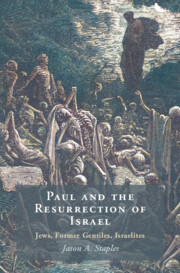Book contents
- Paul and the Resurrection of Israel
- Paul and the Resurrection of Israel
- Copyright page
- Dedication
- Contents
- Figures
- Tables
- Preface
- Acknowledgments
- Introduction
- 1 The God of Jews Only?
- 2 Paul and the Israel Problem
- 3 The Israel Problem and the Gentiles
- 4 Salvation through Justification
- 5 “Not My People”
- 6 God’s Justice and the End of the Torah
- 7 The Mystery of Israel’s Salvation
- 8 The End of the Matter
- Bibliography
- Primary Sources Index
- Author Index
- Subject Index
1 - The God of Jews Only?
Published online by Cambridge University Press: 02 November 2023
- Paul and the Resurrection of Israel
- Paul and the Resurrection of Israel
- Copyright page
- Dedication
- Contents
- Figures
- Tables
- Preface
- Acknowledgments
- Introduction
- 1 The God of Jews Only?
- 2 Paul and the Israel Problem
- 3 The Israel Problem and the Gentiles
- 4 Salvation through Justification
- 5 “Not My People”
- 6 God’s Justice and the End of the Torah
- 7 The Mystery of Israel’s Salvation
- 8 The End of the Matter
- Bibliography
- Primary Sources Index
- Author Index
- Subject Index
Summary
This chapter summarizes evidence from the Second Temple period for the relationship between the terms “Israel/Israelite” and “Jew.” Challenging the previous consensus (insider/outsider) paradigm and its origins with Nazi scholar K.G. Kuhn, this chapter argues that the distinction between these terms is rooted in the biblical distinction between Israel and Judah, with “Jews” a subset of the larger category of “Israel,” a label also claimed by Samaritans (who were not Jews). Finally, the chapter connects the persistence of this terminological distinction with the theological paradigm of restoration eschatology, in which Jews continually recognize that the restoration of all Israel (including the tribes of the former northern kingdom) remains a future hope—an especially foundational paradigm in earliest Christianity.
Keywords
- Type
- Chapter
- Information
- Paul and the Resurrection of IsraelJews, Former Gentiles, Israelites, pp. 37 - 67Publisher: Cambridge University PressPrint publication year: 2023

